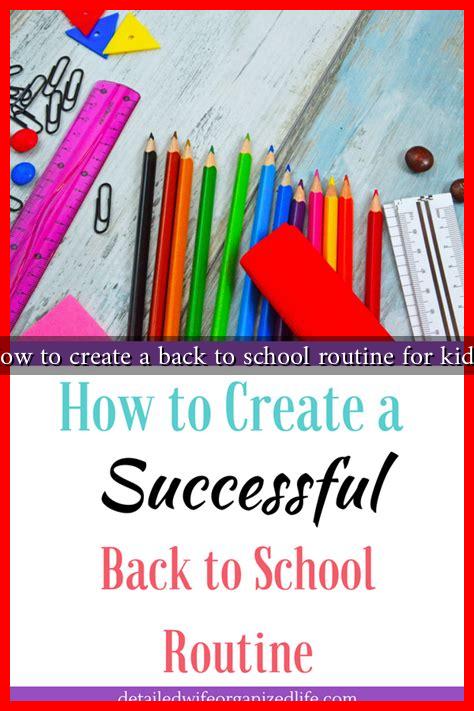-
Table of Contents
- How to Create a Back to School Routine for Kids
- Understanding the Importance of a Routine
- Steps to Create an Effective Back to School Routine
- 1. Set a Consistent Sleep Schedule
- 2. Organize School Supplies and Homework Space
- 3. Plan Healthy Meals and Snacks
- 4. Establish After-School Activities
- Involve Your Child in the Process
- Monitor and Adjust the Routine
- Conclusion
How to Create a Back to School Routine for Kids
As summer winds down and the school year approaches, parents often find themselves in a whirlwind of preparations.
. Establishing a back-to-school routine is essential for helping children transition smoothly from the carefree days of summer to the structured environment of school. A well-planned routine not only aids in academic success but also promotes emotional well-being. This article will guide you through the steps to create an effective back-to-school routine for your kids.
Understanding the Importance of a Routine
Routines provide children with a sense of security and predictability. According to a study published in the journal *Child Development*, children who have structured routines tend to exhibit better emotional regulation and academic performance. Here are some key benefits of establishing a routine:
- Reduces Anxiety: Knowing what to expect can alleviate stress for both parents and children.
- Improves Time Management: A routine helps children learn to manage their time effectively.
- Encourages Responsibility: Children learn to take ownership of their tasks and commitments.
Steps to Create an Effective Back to School Routine
1. Set a Consistent Sleep Schedule
One of the most critical aspects of a back-to-school routine is ensuring that children get adequate sleep. Research from the National Sleep Foundation indicates that children aged 6-13 need 9-11 hours of sleep per night. To establish a consistent sleep schedule:
- Gradually adjust bedtime and wake-up times a week before school starts.
- Create a calming bedtime routine that includes activities like reading or taking a warm bath.
- Limit screen time at least an hour before bed to promote better sleep quality.
2. Organize School Supplies and Homework Space
Having a designated area for school supplies and homework can significantly enhance productivity. Here’s how to set it up:
- Involve your child in selecting and organizing their school supplies.
- Create a clutter-free homework station equipped with necessary tools like pencils, paper, and a computer.
- Establish a system for tracking assignments and deadlines, such as a calendar or planner.
3. Plan Healthy Meals and Snacks
Nutrition plays a vital role in a child’s ability to focus and learn. Planning meals ahead of time can save stress during busy school days. Consider the following:
- Involve your child in meal planning to encourage healthy eating habits.
- Prepare snacks in advance, such as cut fruits, yogurt, or whole-grain crackers.
- Ensure breakfast is a priority; studies show that children who eat breakfast perform better academically.
4. Establish After-School Activities
After-school time can be a great opportunity for children to unwind and engage in extracurricular activities. Here are some ideas:
- Encourage participation in sports, music, or art classes to foster creativity and teamwork.
- Set aside time for reading or educational games to reinforce learning.
- Incorporate family time into the routine, such as game nights or outdoor activities.
Involve Your Child in the Process
Involving your child in creating their routine can increase their commitment to it. Discuss the importance of each element and allow them to express their preferences. This collaborative approach not only empowers them but also fosters a sense of responsibility.
Monitor and Adjust the Routine
Once the routine is established, it’s essential to monitor its effectiveness. Be open to making adjustments based on your child’s feedback and changing needs. Regular check-ins can help identify what’s working and what isn’t, ensuring that the routine remains beneficial.
Conclusion
Creating a back-to-school routine for kids is a vital step in ensuring a successful transition from summer to school. By establishing a consistent sleep schedule, organizing school supplies, planning healthy meals, and involving your child in the process, you can create a supportive environment that fosters learning and emotional well-being. Remember, routines are not set in stone; they should evolve as your child grows and their needs change. For more tips on parenting and education, visit Understood.org.





